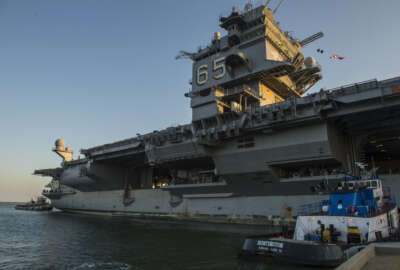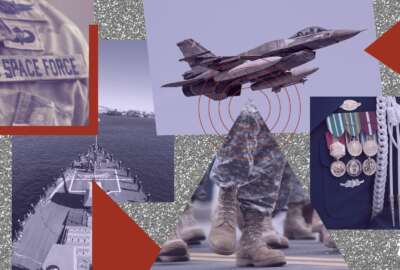An old lesson worth relearning: The best acquisitions start with the best requirements
For the military, nothing much happens without good requirements. Vic Steinman is the air warfare requirements coordinator for the Navy. His work earned him a...
For the military, nothing much happens without good requirements. Vic Steinman is the air warfare requirements coordinator for the Navy. His work earned him a Defense Acquisition Workforce Award. The Federal Drive with Tom Temin will be interviewing several of the award winners, all of whom are Defense Department civilians. First, right here, Mr. Steinman.
Interview transcript:
Tom Temin
Let’s begin with what you do what is an air warfare requirements coordinator? And what does the work entail?Vic Steinman
In the [Office of the Chief of Naval Operations (OPNAV)] staff, which is largely responsible in the Title 10 authorities, as you know, for organized train equip. We have responsibilities, both fiduciary and we invest a lot of human capital in the management of resources and allocation and the planning and programming and budgeting cycle. We have an equivalent responsibility, that is the part that I play, that represents the requirement. And I tend to say the valid progression of deliberate requirements to support whatever we have the responsibility to resource.Tom Temin
Because the Navy, has planes and it has ships and so forth. And you’re concerned with what flies, because it’s air warfare requirements. Is this something that is done annually, the rolling up of these requirements? How does it get to the point where the requirements are established?Vic Steinman
It’s actually a daily job and it has several degrees of kind of depth or outlook. In terms of just programs in air warfare, pretty much from air to ground weapons, air to air weapons, flying platforms, both fixed wing and rotary wing up to an including aircraft carriers. It spans mainly the programs that we have isolated to the directorate up in air warfare. And my daily job or kind of responsibilities here, are to assist as part of a matrix workforce to support all requirements officers and their branches across those platforms.Tom Temin
Is this then episodically based? In other words, if there is a training exercise coming up, or if there is a ship and a carrier, say, that is to deploy. Then the elements involved with carrying that out, would need to know what their requirements are in terms of fuel and people and other equipment and maintenance supplies, and so on. And that somehow comes all through you, then gets translated into something that’s meaningful for acquisition.Vic Steinman
That role and responsibilities, generally begin with our type command. So our Commander, Naval Air Forces, has responsible for the day to day operations and up to including most of those things that would be inside the palm. At the service staff here, the requirements that we look at are the enhancement improvement or modification of current programs that need to stay relevant across the spectrum, and what investments we would make with our acquisition partners. A smart way to keep those things pacing threats, and also really the development of any new requirements. So as new or platforms are replaced, or software hardware solutions are invoked, at whatever scale. They’re written, in what we term as a deliberate fashion. You may have heard of the (JCIDS) system, the Joint Capability Integration Development System, which is really a rubric that lays out, kind of a methodical stepwise process, to capture, convey and validate requirements that are then met with the appropriate resources over the introduction, fielding and operations of any platform.Tom Temin
So for example, if a new type of weapon update was introduced, to put on the bottom of a airplane wing, for example, I’m just making this up. That could translate into lots of details that have to be thought of by your group. Such as how it disengages the bolts, all of the little electromechanical parts that turn that into a reality, so that it’s actually operational. Those are all requirements, right?Vic Steinman
100%. That’s exactly right, Tom. And actually, where we capture as the sponsor in the validated requirements document, they’re at a level that’s just a fidelity that’s just a bit higher than where you’re at. That serves as a great umbrella document that really, in a broad way, determines what the item will do about when or how we would field it at a time and then what are the total lifecycle costs. Those documents become the statutory introduction to the acquisition community and then a good program manager takes that and they derive, little R’s we call them, or many many multitudes of smaller requirements that meet the larger requirement and ultimately go out and as contracts specification and deliverables from our valued partners and industry.Tom Temin
We’re speaking with Vic Steinman. He’s air warfare requirements coordinator for the Navy. And by the way, I congratulate anyone who can keep their equilibrium living within the [Program Objective Memorandum (POM)] cycle, because that’s something beyond most people’s ability to be patient through. But how did you get this award? A specific project that you did that caught the attention of the uppers?Vic Steinman
I’m a little lost to answer that question. I have had a long career in active duty and government employment. And this one took me a little bit by surprise. We do have lots of current initiatives that are going, I could dabble on that a little bit. But I have to take just a moment to give a shout out to the individual that I learned from, James Mongo Rowley. It took me about two years, in the saddle here of the last 10, to really gain a kind of an insight and how to look at requirements and the value of words. But I would suggest that there’s just so much that crosses the plate, and it’s really a treat for me, believe it, it’s not work, to come in and take and to be a support asset for new requirements officers. Because our active duty folks, they come and go through here on 24, 36 months cycles. And it’s just a really great partner and we have up there and to be of some help or assistance with them. And because a lot of this stuff is very new to them as they enter the building. It’s really been a real pleasure.Tom Temin
Well, maybe give us an example of a new program or a new system that resulted in these, as you put it, high fidelity requirements. Maybe walk us through a recent project, so we can get some idea of what you do.Vic Steinman
I can, topically maybe, lists several things that are in play that have recently been met some modicum of success. Right now, we’ve just kind of in the throes of finishing and getting out for review a requirements document for a hypersonic air launched weapon. We also have in play, that’s a deliberate acquisition and a deliberate requirement generation. We’re working in other vehicles, like a software initial capabilities document, for a new planning system and kind of a planning continuum. We used to plan missions and get them uploaded into aircraft and network them. Now we’re looking more at the planning and the conduct of the mission and the debrief and a new architecture. Also, another software ICD, where we’re looking at capturing the requirements, that might develop largely the software and effort we call autonomy that might move us into a kind of a crawl, walk, run in our manned, unmanned or crude and uncrewed teaming, to reap the benefits of that. So a software development effort. A lot of the things we do, I’ve assisted in fact, new development. I try to look for things that are available as answers without jumping to new development. And oftentimes, we look for answers that might be available, without an extraordinarily expensive and lengthy development period. One that has proved to be a great success was repurposing V-22 aircraft, which the Marine Corps had great success with and which the Navy, we had 98, did a document to embrace that airplane as a replacement for the carrier onboard delivery aircraft. And it’s working and working well. We’ve done that with training aircraft as well. H-57 helicopter was just an incredibly duty airplane, and we replaced it with commercially derived airplane without developmental costs.Tom Temin
So does that mean that the long sought dream of everyone who’s ever been on a carry on board aircraft, will have a window to look out of?Vic Steinman
I’m going to stop short of that, sir. But I’d have to validate that one. That’s a great question. I’m not going to commit.Tom Temin
Well, that’s the requirement I would put in, but I don’t have any authority over these things. But it sounds like you really derive great satisfaction from the work you do.Vic Steinman
I really do. I hope it’s not strange to say, but it is incredibly rewarding to come back and be with a lot of the people here. It seems like not that many years ago, I was in that position. And it is wonderful, to in some small way, impart a little bit of assistance and knowing full well I’d walked that ground before. So in that part, yeah, it is very satisfying.Tom Temin
Yeah. So having been on active duty, as you indicate if I’m correct, then you kind of know what it’s like to live with the things that come out of requirements and now you get a chance to influence them at the front end.Vic Steinman
That’s a fact. And I just have to be very clear though, I’m the first one to say that my opinion, while may be interesting me should not matter. And I really try to use the prudent analysis and seek that. But you’re exactly right. It is nice to participate in that.
Copyright © 2025 Federal News Network. All rights reserved. This website is not intended for users located within the European Economic Area.
Tom Temin is host of the Federal Drive and has been providing insight on federal technology and management issues for more than 30 years.
Follow @tteminWFED
Related Stories

Navy’s first nuclear-powered aircraft carrier being decommissioned, but at what cost?




